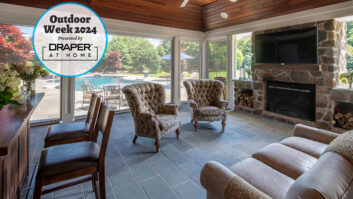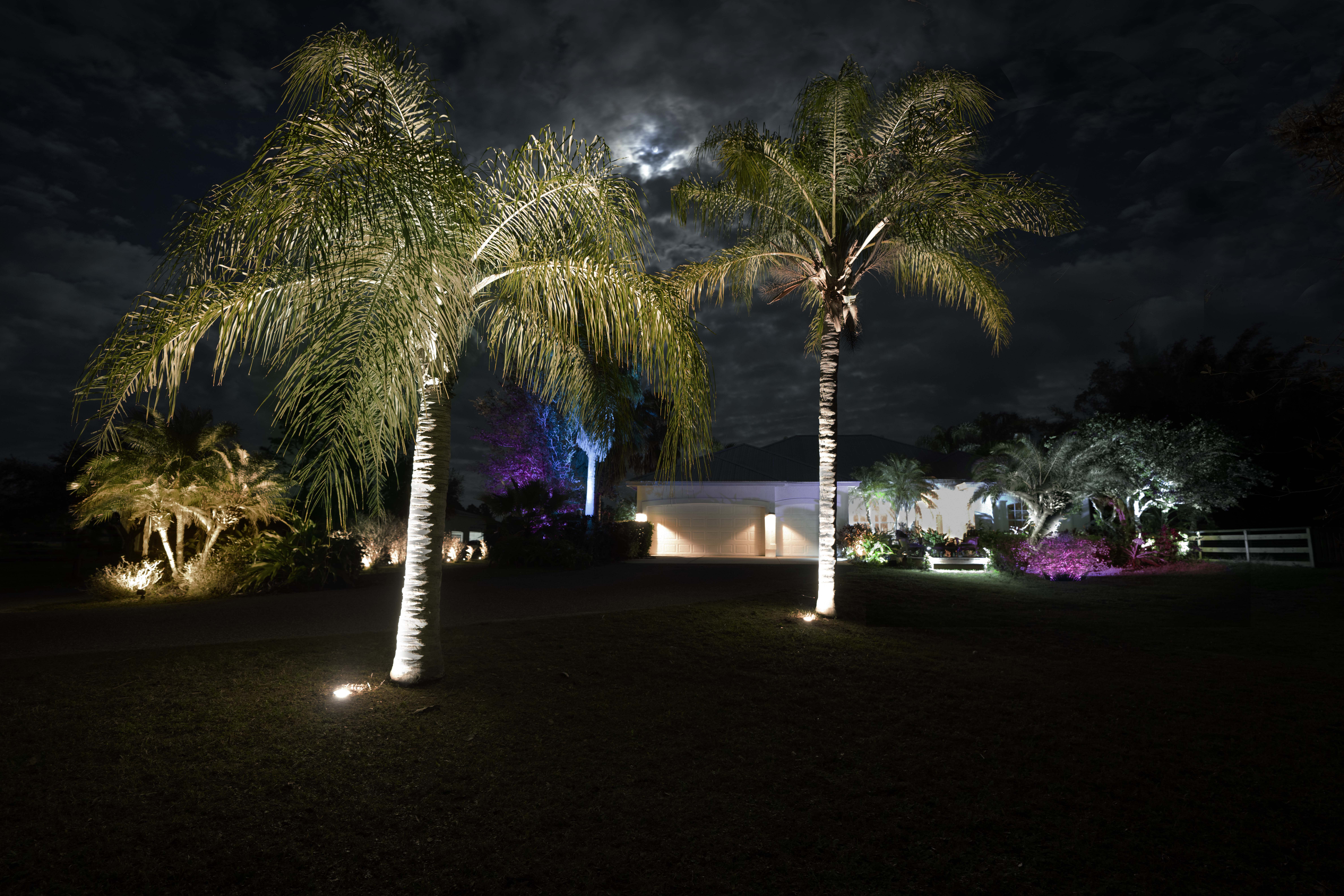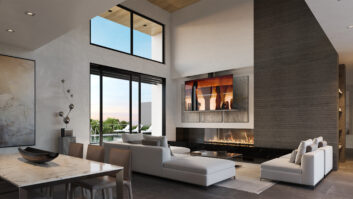Everyone values a quiet home. When it comes to home theater, it is essential. Sound considerations both inside and outside of the theater can effect how much enjoyment homeowners can get out of their entertainment investment.
If you consider why people go out to a theater, or watch a movie in their own home theater, its because they really want to go to another placestop thinking about their bills or other concerns, and just be someplace else for a couple of hours, observed John Dahl, senior fellow and director of THX. You dont want anything, like sounds from the rest of the home or from outside, to intrude or disturb.
Sound can also affect how much a theater is put into use. If the home theater isnt well isolated from the rest of the home, viewing can depend on whether other home dwellers are willing to put up with the roar of engines from that fast and furious action film, or the gunshot claps in that remastered old western. Other aural considerations, such as the home theater as a sanctuary and the simple act of listening to the intelligible silences in a film, are also critical aspects of sound isolation.
Its important to note that the problem of sound isolation is a different topic from the design and control of listening room internal acoustics. Room treatments, such as acoustically absorbent material designed to absorb and minimize sound reflections within the listening room, are largely ineffective at preventing sound from penetrating room walls and migrating to other rooms in the building. A good home theater requires careful planning and attention to both room acoustics and sound isolation, but the two issues need to be addressed independently.
A common term for sound isolation is soundproofing, but Christopher Klein, director of sales and marketing for Acoustic Room Systems, noted that this oft-used term can be misleading. Just as the term bulletproof suggests complete immunity to bullets, the word soundproof may set up unwarranted expectations. Complete sound isolation is nearly impossible in any real-world building. We can merely attenuate the soundsometimes so much so that the sound is masked by other sounds or general ambient noise.
Good results in sound isolation start with careful planning. The first task is to ascertain how much isolation is needed. How large is the family, and what are their needs? Is there a baby or young child who may be sleeping when others are watching a movie or listening to a concert in the theater? If so, that takes a high degree of isolation between the nursery and home theater. Are outside noise levels high due to road traffic or low-flying aircraft? This also raises the stakes.
Room siting is one of the most powerful and effective tools in the acousticians toolkit when it comes to planning a home theater. Highly cost effective, it does not require expensive materials or copious amounts of labor, only good planningespecially when done before constructions begins; retrofitting a home theater is very expensive and difficult. Some of the most important rules to follow include never placing a home theater next to places of solitude (i.e. bedrooms, libraries, and studies) or directly above or below rooms in general; avoid running plumbing in the walls, floors, or ceilings of a home theater as they conduct sound and vibrations; and windows, as poor sound barriers, should not be placed in a home theater.
Sound travels from one room to another along to basic paths: airborne transmission and structure-borne transmission. Even a small air leak can allow significant amounts of sound to travel. Dahl provides a fitting illustration when he points to a floor plate or stud wall made from a warped 2 x 4, which might only have a gap of few thousandths of an inch between it and the subfloor, but which can result in substantial sound transmission. Leaks like this need to be found and caulked.
Electrical boxesused for ceiling lights, wall outlets and switchesare another source of air leaks. Both Kinetics Noise Control and Quiet Solution offer acoustical putty, which can be applied to the back of the electrical box, to seal it. Take particular care to seal around the individual wires, where they exit the back of the box. While the box itself is made airtight, you also need to be sure to caulk around and between the outside of the box as well as the hole in the drywall in which it is mounted.
HVAC ducts make another great sound pathway. Sometimes a duct will pass through one room with a vent into another room with a vent and so on. This sound path in effect short circuits much of the sound isolation provided by the wall. To fix this problem, Dahl suggested providing a dedicated air return from the home theater. In most residential construction, only one or two returns are providedtypically one on each floor. The system depends on air leakage under and around the doors to allow air to escape each room and make its way back to the return.
Throughout the design stage, youll want to work closely with the HVAC contractor to come up with a design that meets both the acoustic needs and the ventilation needs of the room. It is advantageous to dedicate an air handler to the home theater, so that the ductwork for the theater does not serve other rooms in the home. If the theater ductwork is just a branch off the rest of the home, the branching should occur as far from the home theater as possible, and in all cases, ducts should be lined with acoustically absorbent material for maximum sound attenuation per foot. Elbows (bends in the duct) can really help provide a lot of attenuation (except at low frequencies).
You have to worry not only about sound from the theater traveling through the HVAC system to other rooms, but noise from the HVAC system (fans and blowers, for example) intruding on the quiet of the theater. Self-noisecaused by the airflow itselfwill be a serious problem if the ducts are too small, and air velocities too high, so youll want to work with the HVAC contractor to ensure that ductwork is sized to get a nice, quiet, low-velocity airflow into the theater. Kinetics and Engineered Aeroacoustics make duct silencers that fit nicely in the cavity between ceiling joists. Kinetics vice president of sales Larry Holben recommends that the silencer be placed close to the end of the duct that serves the room.
Structure-borne transmission can be the most insidious and most intractable transmission path. Sound can travel from one room to another in numerous indirect ways, known as flanking paths. There are airborne flanking paths and structure-borne flanking paths. Block one path and oftentimes youll find that some of the sound is still getting through via some other flanking path.
The building industry has developed a standardized rating for how much a wall, ceiling, floor or other partition (such as a door or window) attenuates sound transmission. Known as the partitions sound transmission class (STC), it can be loosely described as the number of decibels of attenuation provided by the barrier. But dealers and those designing home theaters or any kind of sound control measures should bear in mind that there are difficulties in assigning a single-number figure of merit to anything as complex as sound transmission, because performance varies with frequency. Also, STC was really developed to measure how much a wall or other barrier will attenuate human speech, which is a much easier task than isolating wideband music.
There are various strategies for maximizing a rooms or a partitions sound isolation. They typically involve mass, vibrational isolation, or constrained-layer damping. When a sound wave reaches a wall or other partition, it actually moves the surface back and forth, due to the pressure variations in the sound wave. The vibrating wall thus radiates sound on the other side, acting like the diaphragm of a loudspeaker. The wall studs give the sound wave a structural flanking path.
Because mass has inertia, adding it is a good way to minimize movement. One way to add mass to a wall, floor, or ceiling structure is with mass-loaded vinyl (MLV), available from most sound control suppliers. MLV is weighted plastic sheeting that typically weighs one pound per square foot. Its effectiveness can vary dramatically according to the application, but it can add from five to as many as 25 STC points to a partition.
The classic way to attack structure-borne sound transmission is to mechanically isolate different parts of the structure from each other. Kinetics Noise Control offers a resilient padding material, known as RIM, that can be used to float the floor of a room, so that there is no rigid connection to the underlying subfloor and building structure. The RIM pad is one-inch thick, and two layers of half-inch plywood are laid down on top of the RIM floating floor system. Flexible polyethylene foam Perimeter Isolation Board is run around the perimeter of the floating floor. Its main function is to keep the floating plywood floor from migrating into contact with any of the walls.
The wallboard of the room can be isolated from the studs by attaching resilient mounting clips to the studs. These mounting clips typically use some type of rubber or other elastomer to grip a metal channel and provide vibrational isolation between the wall stud and the channel (thereby breaking the rigid connection between the drywall and the studs). With the resilient side of the wall facing into the home theater, sounds produced in the home theater are more effectively isolated from the wall studs, and thus from the rest of the building structure. Companies that offer these resilient wall clips include Kinetics Noise Control, PAC International, and Acoustical Solutions.
Constrained-layer damping involves minimizing the natural resonances of panels by sandwiching a highly viscoelastic adhesive between two rigid panels (the panels might be drywall, plywood, sheet metal, or almost anything; the damping is still effective). Quiet Solution offers a line of drywall-substitute panels that use constrained-layer damping called QuietRock. The highest-performance version, QR-545, is the only wallboard certified by THX for home theaters.
Audio Alloy offers Green Glue, a viscoelastic adhesive that can be used to laminate multiple layers of drywall (or plywood for floors) to achieve the same type of constrained-layer damping.
As a dealer, unless your expertise happens to be acoustics, its important to engage the services of an acoustical engineer or other expert. This is a complex field, and it is very easy for something to go wrong or get overlooked. Careful, meticulous quality control during construction is also needed, as a single screw or nail driven in the wrong place can ruin the sound isolation capability of an expensive, elaborately engineered wall or room.
There are acoustical engineers and other consultants in every state. Rives Audio markets its design services through the dealer channel. The firm offers several different levels of involvement, when delivering its services; under Level 1 and Level 2 arrangements, the local dealer provides the customer interface and does all the on-the-scene work, while Rives provides analysis, recommendations, and design review. This arrangement permits Rives to offer services for around $1,000-$1,500 per engagement for Level 1 and about $2300 per engagement for Level 2, according to Rives Audio president Richard Rives Bird. For Level 3 engagements, Rives sends staff on-site, and these engagements are typically individually quoted according to specifics of the job.
Kinetics Noise Control also performs complete engineering as well as on-site installation. Alternatively, dealers can offer the installation, provided they go through Kinetics training program.
Theres a lot to be gained from selling quiet. In this age of increasing competition from a variety of directions, including the Internet and big-box retail chains, its important to have some compelling reasons why your customers and prospects should hire you to build their home theater. Acoustical knowledge and expertise is something relatively rare and scarce. Your job is to acquire that knowledge and experience and, above all, sell your customers on the value of good acoustics and sound isolation. Make sure that they understand how important these qualities are as a key element in any real home theater.
A former loudspeaker designer, Alan R. Frank ([email protected]) is a freelance writer and networking consultant.







